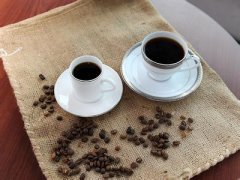Coffee basics how much do you know about coffee beans
Coffee beans grow in tropical or subtropical countries centered on the equator, known as the coffee belt, and travel to Japan on ships. Before the tea brown coffee beans appear in front of your eyes, they have actually gone through various circulation processes with many hands.

Coffee is widely distributed in South America, Central America, West Indies, Asia, Africa, Arabia, South Pacific and Oceania. In terms of output, Brazil ranks first in the world (about 30%), followed by Central and South America centered on Colombia (about 10%), accounting for 60%, followed by Africa and Arabia, accounting for about 30%, and the remaining 10% distributed in Asian countries and most islands.
About Coffee Beans
Small and round dark brown coffee beans, in the grinder quietly exudes a fragrant fragrance, into the cup to present the beautiful color of amber, this is the average person for coffee very deep impression of three.
As you explore the history of coffee and its beauty, you can also see the coffee trees that are being caressed by the tropical sun and their green leaves sparkle. It has a small white flower similar to jasmine, and its fruit changes from green to yellow green and finally turns red. Coffee beans are the seeds in its fruit.
Also, if you visit a coffee bean refiner, you will surely see the red flesh called coffee cherries and the fresh green beans with the endocarp and silver skin removed. These are the coffee beans for export.
At present, coffee is produced in about 60 countries, most of which are located in areas with an elevation of 300-400 meters. Sometimes coffee trees are cultivated in highlands with an elevation of 2000-2500 meters, but those planted on hillsides above 1500 meters are said to have better quality.
The most suitable conditions for growing coffee trees are: annual rainfall of 1500-2000 mm, and the average temperature of about 20 degrees, will not fall frost areas.
The coffee tree is an evergreen tree belonging to the Accanaceae family. If it is wild, it can grow to more than eight meters. However, in the farm, the height is cut to about two meters to maintain the quality of coffee beans and facilitate management.
At present, the most important tree species planted are Arabica species, Robusta species (Kanefra species) and Liberica species. It can be subdivided into dozens of varieties, in production, circulation and trading, will also be distinguished.
Even in the same producing country, the climate, altitude and soil quality of each region have subtle effects on the flavor and quality of coffee beans, as well as their own characteristics. Therefore, depending on the variety, origin, different, will have their own different attributes: it is impossible to describe the characteristics of a country's coffee beans in just one sentence!
● From coffee cherries to green coffee beans
About Green Coffee Beans
A coffee tree can produce about 3-5 kilograms of coffee cherries and can be refined into one-fifth of the weight of green coffee beans. Among them, coffee cherries are transformed into green coffee beans by many hands and time.
Arabica and Robusta species
Arabica species account for about two-thirds of the world's coffee production, not suitable for growing in high temperature, low temperature, rainy, less rainy areas, beans are oval shoulder flat, characterized by strong aroma and better quality.
Robusta is bitter and not sour, and the aroma is not very good, so it is suitable for making mixed coffee. Robusta seeds mixed with Arabica seeds are often used to brew iced coffee, instant coffee, and canned coffee. It is characterized by growing in lowlands. Disease resistance.
The quality and yield of Liberica species are poor, and most of them are exported to Europe, but not imported to Japan.
Flat beans and round beans
Ripe and red coffee cherries have multiple structures. In the middle is the precursor of coffee beans, light green seeds. Generally speaking, coffee fruit is composed of two oval seeds opposite each other. The other side of the joint is a flat joint, so it is called flat beans. But there are also ones that consist of a round seed and taste no different.
From harvest to shipment
After harvest, the fruit must be removed from the outer skin, pulp, endocarp and silver skin before being shipped to the market. There are two methods: drying (also known as natural method or non-washing) and washing.
The dry method is simpler. First of all, just picked fruit will be widely spread in the sun field for a week or two, until the fruit issued a cracking sound so far, natural drying. After that, the husker removes the dried pulp, endocarp and silver skin.
Coffee beans refined in this way are slightly sour and bitter. Almost all coffee beans grown in Brazil, Ethiopia, Yemen, etc. are obtained in this way. The disadvantage of this method is that it is easily affected by weather and easily mixed with defective beans and other impurities. Therefore, teachers must be carefully selected.
Another method is washing, that is, the harvested fruit is placed in a flowing tank, after removing the floating fruit, the skin and pulp are removed by a pulp remover. Then put it in the sink and remove the floating pulp. After that, move into the fermentation tank, soak for half a day to a day, and then dissolve the colloid on the surface of the fermented coffee beans. After washing with water, drying for several days, drying with a machine, and finally removing the endocarp with a huller, it becomes a raw coffee bean that can be used as a commodity.
The washed coffee beans are more beautiful in color and less impurities than the dried coffee beans. Colombia, Mexico, Guatemala and other countries about 70% of the production of this method.
Sometimes in the fermentation process, if not handled properly, it may emit fermentation odor and its characteristic sour taste; but if handled properly, all kinds of beans can emit their unique coffee aroma.
In order to be able to reach the destination intact, raw coffee beans are packed into sacks and placed in special containers for long-distance merchant trips.
Important Notice :
前街咖啡 FrontStreet Coffee has moved to new addredd:
FrontStreet Coffee Address: 315,Donghua East Road,GuangZhou
Tel:020 38364473
- Prev

Coffee roasting basic knowledge of how to bake coffee
Since the Arabs discovered the coffee beans, the first way to eat them is to put the whole fruit of the coffee into the mouth and chew it to get its juice. Later, they ground the coffee beans from the fruit and mixed them with animal fat as a physical supplement for caravans to trade far away. After that, around 1000 AD, it was changed to the method of boiling raw beans into soup. Until 13.
- Next

Main producing areas and characteristics of high-quality coffee beans
The main producing areas and the characteristics of strict selection of beans at present, due to the wide variety of imported coffee beans from all over the world, it is impossible to choose. Here, we will introduce the main producing areas and the characteristics of coffee beans as a reference for you to choose and buy coffee. The main producing area of coffee and the characteristics of strict selection of beans * Brazil (South America) is the world's number one coffee producer and exporter. Due to its distribution in all parts of the country
Related
- Beginners will see the "Coffee pull flower" guide!
- What is the difference between ice blog purified milk and ordinary milk coffee?
- Why is the Philippines the largest producer of crops in Liberia?
- For coffee extraction, should the fine powder be retained?
- How does extracted espresso fill pressed powder? How much strength does it take to press the powder?
- How to make jasmine cold extract coffee? Is the jasmine + latte good?
- Will this little toy really make the coffee taste better? How does Lily Drip affect coffee extraction?
- Will the action of slapping the filter cup also affect coffee extraction?
- What's the difference between powder-to-water ratio and powder-to-liquid ratio?
- What is the Ethiopian local species? What does it have to do with Heirloom native species?

